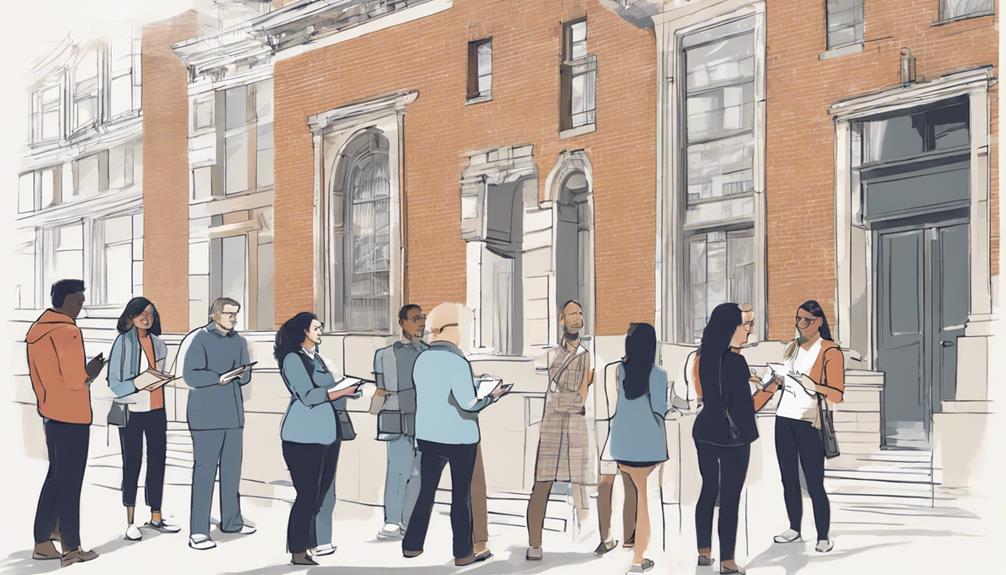7 Top Tips for Small Group Architecture Tours"
To enhance your small group architecture tours, focus on researching architectural styles like Modernist and Gothic to understand their design principles. Strategically plan your itinerary to maximize exploration time and cater to diverse preferences within the group. Hiring knowledgeable guides with backgrounds in architecture will provide nuanced insights. Prioritize visiting iconic landmarks for a deeper understanding of architectural significance. Embrace interactive experiences like workshops for hands-on engagement. Capture memorable moments through photography, utilizing lighting and composition techniques. Seek feedback to continuously improve your tours. Mastering these top tips will ensure a transformative exploration of architectural wonders.
Research Architectural Styles
When researching architectural styles for small group architecture tours, focus on understanding the unique characteristics and historical significance of each style to enhance your appreciation of the buildings you'll encounter.
Modernist architecture, known for its minimalist approach and emphasis on function over ornamentation, emerged in the early 20th century as a response to the industrial revolution. Understanding the principles of Modernist design, such as clean lines and open floor plans, will allow you to appreciate the simplicity and efficiency of buildings like the iconic Farnsworth House.
On the other hand, Gothic architecture, with its pointed arches, ribbed vaults, and flying buttresses, flourished during the medieval period. Delve into the intricate details of Gothic cathedrals such as Notre Dame de Paris to grasp the ingenuity and spiritual symbolism embedded in their design.
Art Deco, a style that originated in the 1920s and 1930s, is characterized by geometric shapes, vibrant colors, and luxurious materials. Explore the opulence of Art Deco skyscrapers like the Chrysler Building to understand how this style captured the essence of modernity and glamour.
Lastly, Brutalist design, with its raw concrete facades and bold, imposing structures, gained popularity in the mid-20th century. Analyze the functionality and stark beauty of Brutalist buildings like the Barbican Centre in London to appreciate their unapologetic aesthetic.
Plan Itinerary Wisely
To ensure a well-organized and enriching small group architecture tour, strategically plan your itinerary to maximize your exploration of diverse architectural styles and landmarks. Time management is crucial when planning your itinerary. Consider the travel time between each location, the time needed to explore each site thoroughly, and factor in breaks for rest and meals. Allocate more time at significant architectural sites where group discussions and interactions are likely to be longer. By carefully managing time, you can ensure that your group experiences each location fully without feeling rushed.
Group dynamics play a significant role in planning your itinerary. Take into account the interests and preferences of the individuals in your group. Some may be more interested in modern architecture, while others may prefer historical buildings. Try to strike a balance in your itinerary to cater to the diverse preferences within the group. Additionally, consider the physical abilities of all participants when planning visits to different sites. Ensure that the tour is accessible to everyone in the group to make the experience enjoyable for all.
Hire Knowledgeable Guides
For an enriching and educational small group architecture tour, securing the services of knowledgeable guides is essential. Engage experts who are well-versed in the local architecture scene and can provide in-depth insights into the history, design principles, and cultural significance of the buildings you visit. A knowledgeable guide can enhance your tour by sharing fascinating anecdotes and lesser-known facts that you might otherwise miss.
When hiring guides for your architecture tour, look for individuals with a background in architecture, art history, or a related field. These experts can offer a more nuanced perspective on the structures you explore, helping you appreciate the finer details and design elements that contribute to the overall aesthetic. Their expertise allows you to delve deeper into the architectural styles, construction techniques, and historical context of each building, making the tour both informative and engaging.
Exploring history with a knowledgeable guide adds depth to your architectural journey. They can contextualize the buildings within the broader historical timeline, connecting architectural trends to societal developments and cultural movements. By understanding the historical background of each structure, you gain a deeper appreciation for its significance and contribution to the architectural landscape.
Prioritize Iconic Landmarks
Securing the services of knowledgeable guides is crucial for an enriching small group architecture tour. When exploring iconic landmarks, focusing on well-known structures can provide a captivating insight into architectural history and cultural significance. Iconic structures, such as the Eiffel Tower in Paris, the Sydney Opera House in Australia, or the Guggenheim Museum in New York, aren't only visually striking but also hold immense architectural significance.
By prioritizing visits to these iconic landmarks, you can delve into the stories behind their creation, the vision of the architects who designed them, and the impact they've had on the local community and the world at large. For instance, learning about the innovative use of materials and engineering techniques in the construction of the Burj Khalifa in Dubai can offer a deeper appreciation for modern architectural advancements.
Moreover, iconic landmarks often serve as cultural symbols, reflecting the values and aspirations of a society. Exploring the historical context in which these structures were built can provide valuable insights into the societal norms and architectural trends of the time. By immersing yourself in the architectural marvels of iconic landmarks, you can gain a profound understanding of how architecture shapes and is shaped by the world around us.
Embrace Interactive Experiences
Immersing yourself in interactive experiences during small group architecture tours can significantly enhance your understanding and appreciation of architectural marvels. Interactive workshops offer a unique opportunity to delve deeper into the world of architecture by allowing you to engage with the design process firsthand. These workshops often involve hands-on learning experiences where you can experiment with architectural concepts, materials, and techniques under the guidance of skilled professionals. By actively participating in these activities, you not only gain practical insights into the architectural field but also develop a greater sense of connection to the structures you're exploring.
During these interactive workshops, you may find yourself sketching out your own architectural designs, constructing models, or even trying your hand at basic construction tasks. These activities provide a dynamic way to learn about the principles of architecture in a fun and engaging manner. Through hands-on learning, you can grasp the complexities of architectural design in a more tangible way, fostering a deeper appreciation for the thought and skill that goes into creating iconic buildings.
Capture Memorable Moments
To truly encapsulate the essence of your small group architecture tour, consider capturing memorable moments through photography or journaling. Photography can be a powerful tool to document the unique designs, intricate details, and overall atmosphere of the architectural wonders you encounter.
To make the most of your photography experience, here are a few tips to keep in mind:
Firstly, pay attention to lighting. Natural light can enhance the beauty of a building, so try to schedule your tours during the golden hours of sunrise or sunset. Experiment with different angles to find the most flattering light and shadows that bring out the architectural elements.
Secondly, focus on composition. Instead of simply taking wide shots of buildings, look for interesting perspectives and details that tell a story. Utilize leading lines, framing techniques, and symmetry to create visually compelling images that draw viewers into the scene.
Lastly, consider the power of storytelling through your photographs. Each building has a history and a unique character waiting to be captured. Try to convey the emotions and significance of the architecture through your images, allowing viewers to connect with the spaces on a deeper level.
Seek Feedback for Improvement

Consider seeking feedback from fellow participants and tour guides to enhance the quality of your small group architecture tours. Feedback is a valuable tool that can provide you with insights into what worked well during the tour and areas that may need improvement. One effective way to gather feedback is by creating a feedback survey that participants can fill out after the tour. Ask questions about their overall experience, the knowledge shared, the pace of the tour, and any suggestions they may have for future tours. Analyzing the responses can help you identify patterns and areas where adjustments can be made to enhance the tour experience for everyone involved.
In addition to feedback surveys, engaging in tour reflections with both participants and guides can offer a more in-depth understanding of the tour dynamics. Reflecting on the tour together allows for open discussions about what aspects were successful and what could be improved. It also provides a platform for sharing different perspectives and ideas for future tours. By actively seeking feedback and engaging in reflective discussions, you demonstrate a commitment to continuous improvement and creating a more enriching experience for all involved in your small group architecture tours.
Frequently Asked Questions
Can Children Participate in Small Group Architecture Tours?
Yes, children can participate in small group architecture tours. These tours offer child-friendly activities that make the experience engaging and educational for young participants.
Exploring architectural wonders can be a fun and enlightening experience for kids, allowing them to learn about design, history, and culture in an interactive way.
Are There Any Restrictions on Photography During the Tour?
During the tour, follow the photography rules closely to respect privacy concerns. Be mindful of any restrictions in place and avoid taking photos where prohibited.
Remember that some areas may have specific guidelines to ensure everyone's privacy and enjoyment. Stay aware of your surroundings and be considerate of others when capturing moments during the tour.
Respecting these guidelines will help maintain a positive experience for all participants.
Is There a Minimum Number of Participants Required for Tours?
For small group architecture tours, the group size typically influences tour availability. Most tours require a minimum number of participants to ensure the experience is worthwhile for everyone involved. This minimum threshold helps cover costs and ensures the tour can proceed as planned.
Before booking, it's essential to check the group size requirements to avoid any potential cancellations due to not meeting the minimum number of participants.
What Is the Cancellation Policy for Architecture Tours?
If you need to cancel your architecture tour, the cancellation policy typically outlines the timeframe within which you can receive a refund. Refund options may vary based on how far in advance you cancel.
Be sure to review the specific terms and conditions regarding cancellations before booking your tour. It's important to understand the cancellation policy to avoid any unexpected fees or charges.
Are There Any Special Accommodations for Individuals With Disabilities?
For individuals with disabilities, accessible accommodations are provided to ensure inclusive experiences during the architecture tours. Special arrangements can be made upon request to cater to specific needs and ensure everyone can fully participate in the tour.
These accommodations aim to create a welcoming environment for all participants, allowing everyone to enjoy and appreciate the architecture without any limitations or barriers. Your comfort and enjoyment are our top priorities during the tour.
Conclusion
In conclusion, by following these 7 top tips for small group architecture tours, you can ensure a memorable and enriching experience for all participants.
Researching architectural styles, planning the itinerary wisely, hiring knowledgeable guides, prioritizing iconic landmarks, embracing interactive experiences, capturing memorable moments, and seeking feedback for improvement are key steps to creating a successful tour.
With these strategies in place, your small group architecture tour is sure to be a success.
